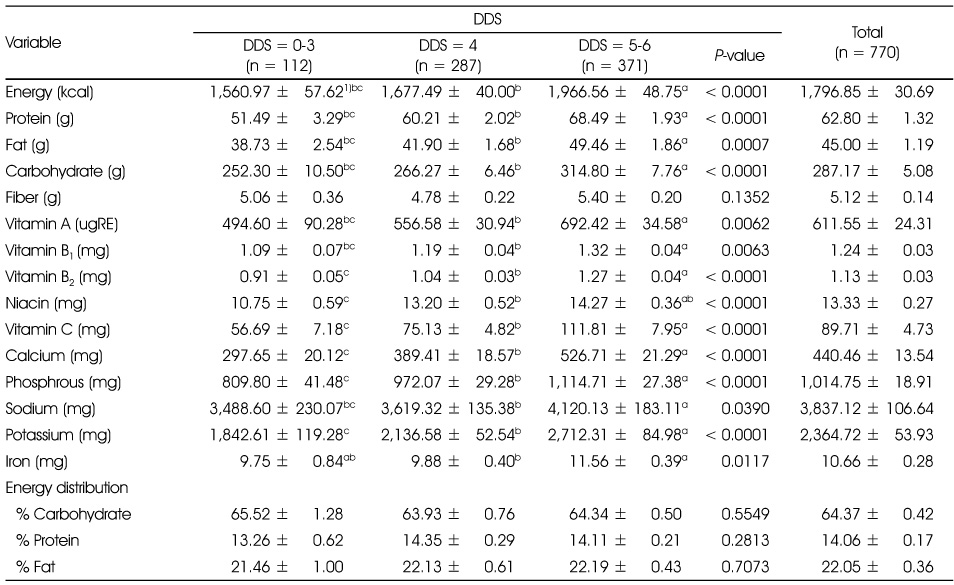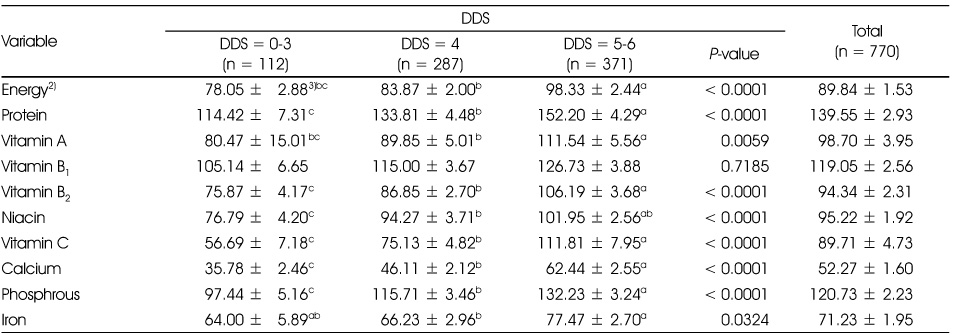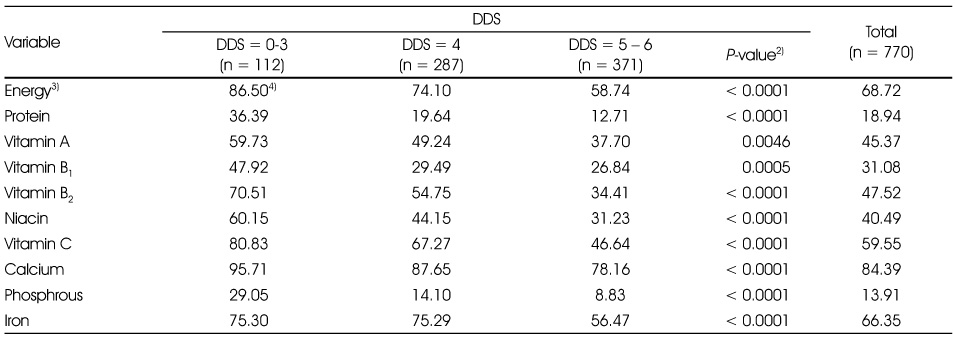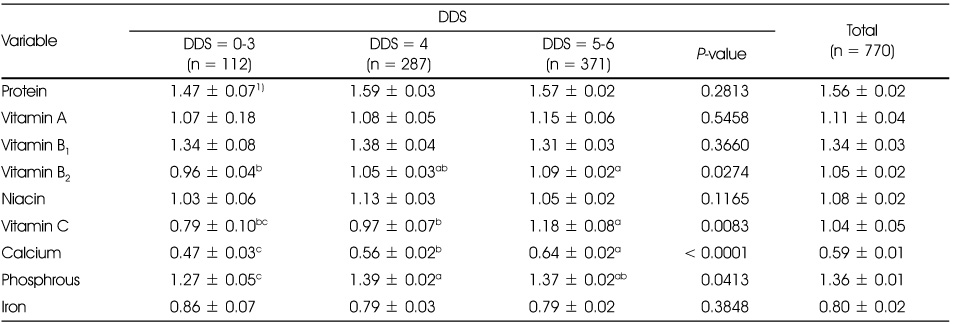References
1. Al-Kloub MI, Al-Hassan MA, Froelicher ES. Predictors of obesity in school-aged Jordanian adolescents. Int J Nurs Pract 2010. 16(4)397–405.
2. Azadbakht L, Esmaillzadeh A. Dietary diversity score is related to obesity and abdominal adiposity among Iranian female youth. Public Health Nutr 2011. 14(1)62–69.
3. Hansen RG. An index of food quality. Nutr Rev 1973. 31(1)1–7.
4. Hansen RG, Wyse BW. Expression of nutrient allowances per 1,000 kilocalories. J Am Diet Assoc 1980. 76(3)223–227.
5. Jang HS. Evaluation of nutrient intakes and diet quality of rural middle school students. Korean J Community Nutr 2001. 6(Suppl)486–494.
6. Kant AK, Block G, Schatzkin A, Ziegler RG, Nestle M. Dietary diversity in the US population, NHANES II, 1976-1980. J Am Diet Assoc 1991. 91(12)1526–1531.
7. Kim BR, Cho YE. A study on the evaluation of food intake of middle school students in Kangneung. J Korean Soc Food Sci Nutr 2001. 30(5)986–999.
8. Kim DS, Cho Y, Cho SI, Lim IS. Body weight perception, unhealthy weight control behaviors and suicidal ideation among Korean adolescents. J Sch Health 2009. 79(12)585–592.
9. Kim HJ, Yoon JS. Food diversity and nutrient intake of elementary school students in Daegu-Kyungbook area. Korean J Community Nutr 2010. 15(3)297–307.
10. Kim IS, Yu HH, Kim YS. A study on nutrient intake, food behavior and health conditions according to food intake diversity in the elderly in a local city. Korean J Community Nutr 2001. 6(2)205–217.
11. Kim JH, Jung IK. A study on body image perception and eating disorders by gender in junior high school students in Seoul. J Korean Home Econ Assoc 2007. 45(1)101–109.
12. Kim MH, Bae YJ. Evaluation of diet quality of children and adolescents based on nutrient and food group intake and diet quality index-international (DQI-I). Korean J Community Nutr 2010. 15(1)1–14.
13. Kim O, Kim K. Body mass index, body shape satisfaction, and weight control behaviors among Korean girls. Psychol Rep 2005. 96(3 Pt 1)676–680.
14. Kim SH. A review on the relationship of milk consumption, dietary nutrient intakes and physical growth of adolescents. J Korean Dairy Technol Sci Assoc 2010. 28(1)9–16.
15. Kim SH, Kim JY, Ryu KA, Sohn CM. Evaluation of the dietary diversity and nutrient intakes in obese adults. Korean J Community Nutr 2007. 12(5)583–591.
16. Kontogianni MD, Farmaki AE, Vidra N, Sofrona S, Magkanari F, Yannakoulia M. Associations between lifestyle patterns and body mass index in a sample of Greek children and adolescents. J Am Diet Assoc 2010. 110(2)215–221.
17. Korea Centers for Disease Control and Prevention & The Korean Pediatric Society. Body growth standard values of Korean pediatrics and juveniles in 2007 2007. Seoul:
18. Krebs-Smith SM, Smiciklas-Wright H, Guthrie HA, Krebs-Smith J. The effects of variety in food choices on dietary quality. J Am Diet Assoc 1987. 87(7)897–903.
19. Lee JE, Ahn Y, Kimm K, Park C. Study on the associations of dietary variety and nutrition intake level by the number of survey days. Korean J Nutr 2004. 37(10)908–916.
20. McCrory MA, Fuss PJ, McCallum JE, Yao M, Vinken AG, Hays NP, Roberts SB. Dietary variety within food groups: association with energy intake and body fatness in men and women. Am J Clin Nutr 1999. 69(3)440–447.
21. Ministry of Health and Welfare [MOHW] & Korea Center for Disease Control and Prevention [KCDCP]. Korea Health Statistics 2009: Korea National Health and Nutrition Examination Survey(KNHANES IV-3) 2010. Seoul:
22. Mirmiran P, Azadbakht L, Esmaillzadeh A, Azizi F. Dietary diversity score in adolescents - a good indicator of the nutritional adequacy of diets: Tehran lipid and glucose study. Asia Pac J Clin Nutr 2004. 13(1)56–60.
23. O'Dea JA, Wilson R. Socio-cognitive and nutritional factors associated with body mass index in children and adolescents: possibilities for childhood obesity prevention. Health Educ Res 2006. 21(6)796–805.
24. Ries CP, Daehler JL. Evaluation of the Nutrient Guide as a dietary assessment tool. J Am Diet Assoc 1986. 86(2)228–233.
25. Steyn NP, Nel JH, Nantel G, Kennedy G, Labadarios D. Food variety and dietary diversity scores in children: are they good indicators of dietary adequacy? Public Health Nutr 2006. 9(5)644–650.
26. Togo P, Osler M, Sørensen TI, Heitmann BL. Food intake patterns and body mass index in observational studies. Int J Obes Relat Metab Disord 2001. 25(12)1741–1751.
27. Um JS, Park MY, Chung YJ. Composition of food groups appropriate for evaluation of diet quality of Korean adolescents-Based on Kant's minimum amount. Korean J Nutr 2006. 39(6)560–571.
28. Yim KS. Nutrient intake assessment of Korean elderly living in Inje area, according to food group intake frequency. Korean J Food Cult 2008. 23(6)779–792.







